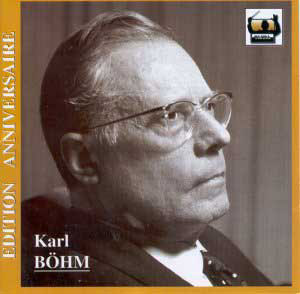Böhm had recorded both these works in 1939 with
the Dresden Staatskapelle. The soloist in the Piano Concerto was the
same, Backhaus, whereas the violinist was Max Strub. I last saw those
performances coupled on LP – in Volume One of the Böhm in Dresden
box set – though doubtless they’ve made subsequent reappearances … and
rightly so. Over a decade later Backhaus and Böhm were taped in
the Concerto in a broadcast recorded by RIAS, Berlin. The conductor
moulds the strings with powerful care but there’s also a slight feeling
of rhythmic insistence. Backhaus is fluent, not at all unstable, if
sometimes guilty of some over-languid phrasing in the first movement.
His cadenza here is also more than slightly hectic in places. The slow
movement’s solemnity is not of the famous Orpheus and the Beasts variety.
There’s less a sense of confrontation and more a feeling of interiority
here, in which the soloist and orchestra become subsumed into a single
line. It conveys a spirit of indivisibility, of an active monologue
and not of a fractious orchestra battening on the reflective-philosophical
piano. These things are of course difficult to convey but both soloist
and conductor maintain the linearity of the argument, its mutual reliance
to the end and I found it a thought provoking view. The Finale begins
rather daintily but soon adopts very slightly stolid tempi and Backhaus
again indulges a rather raucous cadenza.
The Violin Concerto brings to the fore the French violinist
who was so popular in Germany, Christian Ferras. His slim tone hadn’t
yet fully taken on its more abrasive qualities though that rather fast
vibrato is in place. He makes a predictably big slow down for the second
subject and sounds meticulously phrased – really rather too meticulously
phrased for me – as he does so and bordering on mannerism. There’s some
strong and heavy profiling from Böhm as there is in the second
movement. The Berlin basses are deep brown but occasionally a little
immobile. Ferras meanwhile is reverential in his playing though, lacking
the range of tone colours of more opulent players, relies instead on
the prayerful intimacies of his tight vibrato, sure technique and elegant
phrasing. There is a rather extreme orchestral diminuendo from the conductor
before Ferras takes a mini cadenza before the finale. I liked the strength
and power of the orchestral crescendo here, the intensity of the soloist’s
rhythmic emphases. Ferras audibly tires in the cadenza where some roughness
in bowing begins to afflict his playing but trips away cleanly to a
bright conclusion. A predominantly traditional performance then and
one recorded on two successive nights so one supposes some patching
and splicing has been employed. The notes are rather sparse but the
sound is splendid.
Jonathan Woolf

![]() Berlin Philharmonic Orchestra
(Violin Concerto. Recorded 18 and 19 November 1951)
Berlin Philharmonic Orchestra
(Violin Concerto. Recorded 18 and 19 November 1951) ![]() TAHRA 448 [79’46]
TAHRA 448 [79’46]